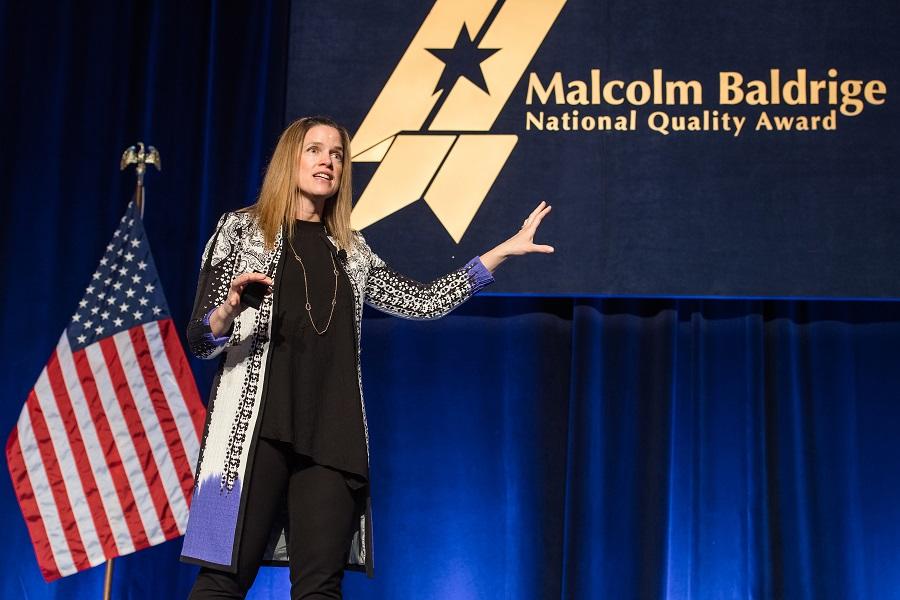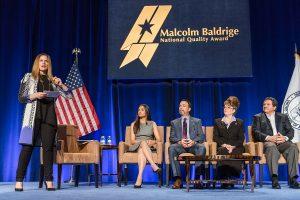Blogrige
The Official Baldrige Blog

Create an innovation advantage for your organization by letting go of industrial-age principles, embracing imagination, and experimenting even if you might fail, said Polly LaBarre, co-founder and director of Management Lab (MLab) and co-founder of MIX (Management Innovation eXchange). LaBarre, who delivered the 29th Annual Quest for Excellence© Conference keynote presentation, said, “You cannot have some big opportunities without having some big misses. . . . Mistakes should be shared and picked apart for every last tidbit of insight.”
LaBarre asked the conference audience, “How do you build the capacity for innovation and the adaptability that keeps your organization growing and thriving?” and “Are you capable of changing as fast as the world is changing? . . . The next game changer probably will come out of nowhere. Your customers, patients, stakeholders have more information, more choice, higher expectations than ever before. . . . In that context, are you constitutionally adaptable?”
The modern industrial-age organization was not built for adaptability and innovation, she said. Instead, the assembly-line plants from years ago were designed “to maximize standardization, specialization, predictability, and control,” said LaBarre, adding that the business model was to “get flesh and blood human beings to become widget-producing robots.”
“All of the practices and systems that we have built and embedded in our organizations [including] budgeting, performance review, ROI calculations, inventory. . . . All of those things were invented over a century ago to routinize the nonroutine,” said LaBarre; “When [today’s] challenge is for every organization to become ever-more adaptable, ever-more innovative, ever-more inspiring and engaging, those principles don’t serve us well. There’s no competitive advantage left. . . . We can’t solve the new problems with the old principles.”
Innovation
LaBarre said that innovation in today’s organizations tends to get compartmentalized if it is not embedded in every activity, every function. “As a result, the 90% of people who do not have a formal innovation role, think of innovation as someone else’s job. And those companies then end up commercializing and capturing just a tiny potential of their people and their organizations,” she said.
The efficiency principles of the industrial age are still critical and necessary, LaBarre said, but to “transcend the inevitable tradeoffs of discipline without the cost and the drag on agility . . . and the crushing of human initiatives,” organizations should also consider pro-innovation principles such as aspiration, experimentation, diversity, freedom, and openness. She illustrated several real organizations who have embedded such principles and asked the audience to consider, “What kind of sustaining advantage can innovation bring?”
The first tip for our organizations, LaBarre said, is to expand autonomy. “Control [of people, information, deviation from the norm] is the wrong design when you want to unleash people’s best imagination, initiative, passion--the human gifts that are in so much demand today but which cannot be commanded or controlled into existence.”
Freedom
LaBarre pointed out that we’ve all experience a huge expansion of freedom in our personal lives, especially with our ability to connect with anyone, anywhere in the world. “We can challenge, speak up, have a voice in the world, but the workplace lags so far behind,” she said, adding that in their personal lives, people can buy houses, cars, etc., but in the workplace, they may not have the authority to purchase a desk chair.
She asked the audience to consider, in their organizations, “Who does the thinking and who does the doing?” She described freedom as giving employees more opportunities and more channels to have meaningful roles.
She shared with the audience that she has traveled around the world looking for organizations that have reinvented their management models, “swapping out industrial bureaucratic DNA for pro-innovation and pro-adaptability.” In some of these companies, LaBarre said she found employees with total autonomy, which is balanced by extensive accountability, especially by coworkers who, for example, conduct each other’s performance reviews. These organizations are growing their leadership capacity, she said.
LaBarre spoke of the “latent creative potential” of employees and cultures of collaboration. Invite everyone to be part of the strategic and creative realm, she suggested. In one organization she visited, LaBarre said she found hundreds of “communities of passion” that work on strategic priorities and local problems, and resolve issues must faster than they could under a standard corporate model.
“Design systems and practices for more headroom and elbow room,” she said, “so people can operate outside of their spheres. . . . People can find natural collaborators, pursue their passions, [find] the slack [they] need for trying new things, for experimenting, and for taking risks.”
Experimentation
“If you want to build innovative, adaptive capacity, there is no more powerful leverage than experimentation,” said LaBarre.
How life itself has flourished is a perfect example of experimentation, according to LaBarre. “Life has become ever more capable and complex in the process without a CEO, SVP, or strategic plan at the helm,” she said. “Evolutionary progress . . . is a product of rampant experimentation. Mutations are mistakes. Let me put it another way, if life was run by Six Sigma, we would all still be slime.”
LaBarre said experimentation is about cycling through ideas, testing assumptions, getting feedback, discarding what isn’t working, and building on what is. “It’s a strategy for measuring your insights,” she said.
Organizations should develop the facility to fail in order to learn, because in the words of Pixar Animation Studios, according to LaBarre, "Pain is temporary. Suck is forever." Or, in other words, she said, Pixar understands that "if you are going to try new things, you’re going to have errors” and that’s how you learn.
Questions
To truly build an innovation capability at your organization, “Ask more questions than you give answers,” she said. “If you’re open, curious, you can surface more possibilities. As a leader, craft stretch questions. . . . Invest as much in what could be as what is. . . . Walk in stupid. . . . Practice the innocence of children to gain fresh eyes to innovation.”
She encouraged the audience to question every orthodoxy in their industries and to hack every process to imbue it with innovation principles. “Questions that no one has asked before spawn innovative answers that no one has sought before,” LaBarre said, adding “invite the subversive in.”

To further explore innovation, senior leaders from the four 2016 Baldrige Award recipients joined LaBarre on stage. They talked about how they define innovation and how they equip people to handle it.
Roger Arciniega, CEO of Momentum, said, “Culture is most important. You need a structure for innovations to break through. A big barrier is employees not wanting to be associated with failure,” adding the importance of not having a “gotcha” mentality.
The health care senior leaders on stage, Maryruth Butler, executive director of Kindred Nursing and Rehabilitation Center - Mountain Valley, and Malisha Patel, vice president of operations at Memorial Hermann Sugar Land, discussed how to stimulate innovation and still ensure patient safety.
Don Chalmers Ford’s Andy Strebe, director of fixed operations, said innovation sometimes means being open to ideas that make you uncomfortable. The leaders also talked about getting out of the way of employees’ ideas, integrating work processes with action plans, looking for innovation in the supply chain, simplifying innovation, trusting employees, and putting down your “pivot foot” (i.e., practicing values-based innovation).
About the author
Related Posts
Comments
- Reply





